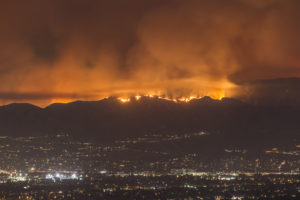 Some of the most destructive wildfires in history occurred in 2018, with nearly 9 million acres burned, over 1.8 million of which were in California alone. California’s Camp Fire was one of the most destructive in the state’s history, with a total loss of $9.3 billion. In a review of 2018’s fires, CoreLogic examined how California’s most extreme wildfires impacted single-family housing in the state.
Some of the most destructive wildfires in history occurred in 2018, with nearly 9 million acres burned, over 1.8 million of which were in California alone. California’s Camp Fire was one of the most destructive in the state’s history, with a total loss of $9.3 billion. In a review of 2018’s fires, CoreLogic examined how California’s most extreme wildfires impacted single-family housing in the state.
Tom Jeffery, Principal, Science and Analytics at CoreLogic, noted how recent wildfires stack up against the past.
According to Jeffery, there is a concerning trend towards larger and more destructive fires, as well as a rising cost of managing these fires.
“The Federal cost of wildfire suppression has gone from $1 billion in 2000 to $2 billion in 2015, and now $3 billion as of 2018 last year,” he said.
Looking at California’s three largest fires in 2018, the Camp fire damaged or destroyed 14,062 structures, the Carr fire impacted 1,263 and the Woolsey fire affected 724; combined over 16,000 structures were damaged or destroyed by these fires. For single-family homes, 2018 saw a drastic increase in damage risk, as nearly 97% of all single-family residences (SFRs) damaged in the three large fires of 2018 were high or extreme Risk, compared to only 36% in 2017.
In total, the Camp and Woolsey fires left behind a trail of losses between $15 billion and $19 billion after being contained in late November 2018. The analysis recorded a total loss in the range of $11 billion and $13 billion from the Camp Fire, the most destructive wildfire in the state’s history. Additionally, estimated losses from Woolsey Fire in Southern California are estimated to be between $4 billion to $6 billion. Residential and commercial properties account for building, content, and additional living expenses. The estimated losses include damage caused by fire, smoke, demand surge and debris removal.The residential loss from the Camp fire alone is between $8 billion to $9 billion. Woolsey fires ravaged infrastructure worth $3.5 to $5.5 billion in the residential space and $0.5 billion in commercial losses.
"The last few years have seen tremendous amounts of loss from wildfire events," CoreLogic notes. "Even though the profiles of 2017 and 2018 events were very different, we can show that the CoreLogic Wildfire Risk Score model works as intended; that lower risk locations have a much lower frequency of damage compared to higher risk locations. And as the risk score increases, the relative chance of damage increases as well."

 DSNews The homepage of the servicing industry
DSNews The homepage of the servicing industry









